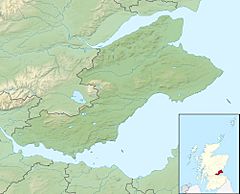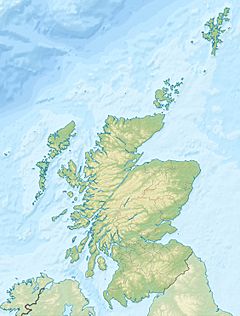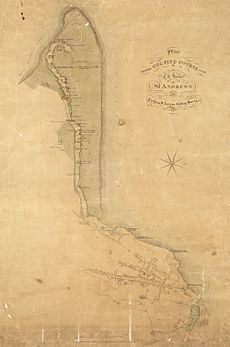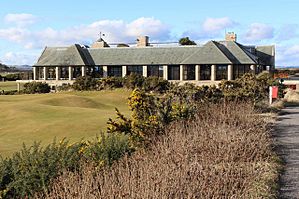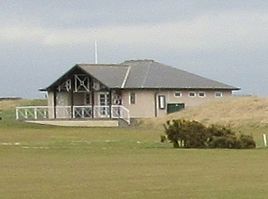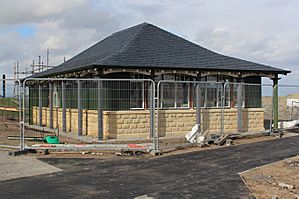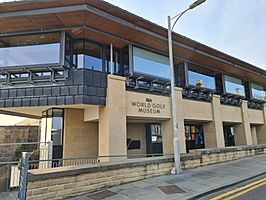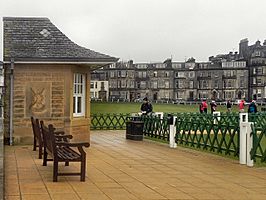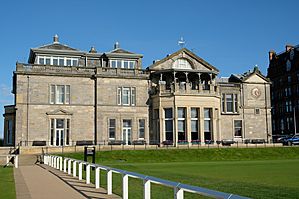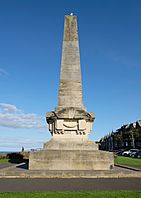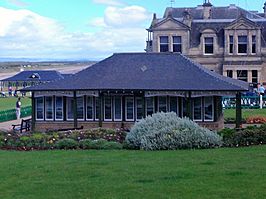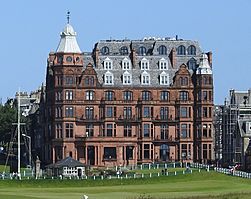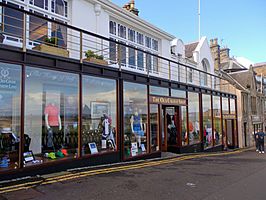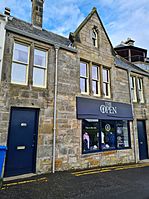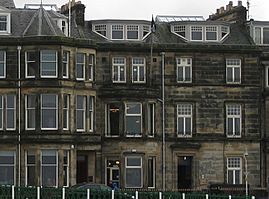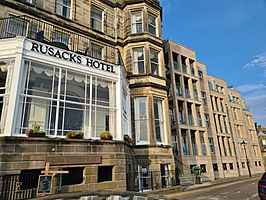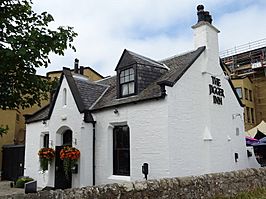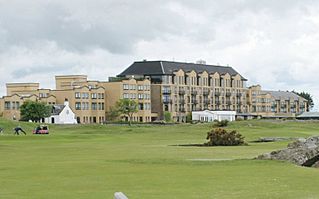Old Course at St Andrews facts for kids
 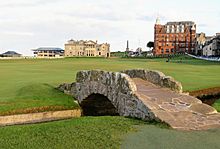
The Old Course's Swilcan Bridge, 2019
|
|
| Club information | |
|---|---|
| Coordinates | 56°20′35″N 2°48′11″W / 56.343°N 2.803°W |
| Location | St Andrews, Fife, Scotland |
| Established | 1552 (472 years ago) |
| Type | Public |
| Owned by | Fife Council |
| Operated by | St Andrews Links Trust |
| Total holes | 18 |
| Tournaments hosted | The Open Championship, Alfred Dunhill Links Championship, St Andrews Links Trophy |
| Website | Old Course |
| Par | 72 |
| Length | 7,305 yards (6,680 m) |
| Course record | 61; Ross Fisher (2017) 61; Tyrrell Hatton (2024) |
The Old Course at St Andrews is often called the oldest golf course in the world. People also know it as the Old Lady or the Grand Old Lady. It's a public course in St Andrews, Scotland. The land is managed by the St Andrews Links Trust for everyone to enjoy.
Many golf clubs use the course. The famous The Royal and Ancient Golf Club of St Andrews has its clubhouse right next to the first tee. The course was first called the "golfing grounds" of St Andrews. It only got the name "Old Course" after a new course opened in 1895.
Contents
History of Golf at St Andrews
Many people believe St Andrews is the "home of golf." This is because golf was first played here in the early 15th century. The sport became very popular in Scotland.
Golf Banned and Brought Back
In 1457, James II of Scotland banned golf. He thought young men were playing too much golf. He wanted them to practice archery instead. The ban continued under James III. But in 1502, James IV started playing golf himself. He then removed the ban.
How the Course Was Managed
In 1552, Archbishop John Hamilton gave the people of St Andrews the right to play golf on the links. Later, in 1754, a group of important people started the Society of St Andrews Golfers. This group eventually became The R&A. The R&A now helps run golf rules everywhere except the United States and Mexico.
The St Andrews Links faced a problem in 1797. The town council allowed rabbit farming on the golf course. This caused a big fight between golfers and farmers. In 1821, a local golfer named James Cheape bought the land. He is remembered for saving the course for golf.
The course changed over many years without one main designer. Important changes were made by Daw Anderson in the 1850s. Old Tom Morris also helped design the 1st and 18th holes between 1865 and 1908. At first, golfers played out and back on the same fairways. As more people played, they often went in different directions on the same hole.
How the Old Course Shaped Golf
The Old Course was very important in creating the game we know today. For example, in 1764, the course had 22 holes. Golfers played the same holes going out and coming back.
On October 4, 1764, William St Clair of Roslin made a big change. He decided that the first four and last four holes were too short. He combined them into four holes. This made the course have 18 holes. This is how 18 holes became the standard for golf courses around the world. Around 1863, Old Tom Morris separated the 1st green from the 17th green. This created the 18-hole layout we see today. The course has 7 shared greens and 4 single greens.
The Old Course is home to The Open Championship. This is the oldest major golf tournament. The course has hosted this event 30 times since 1873. The most recent was in 2022. The Old Course hosts The Open more than any other course. It usually happens there every five years.
Bobby Jones and the Old Course
Bobby Jones was a famous golfer. He later started Augusta National. He first played at St Andrews in the 1921 Open Championship. In one round, he got stuck in a bunker on the 11th hole. He took four swings and couldn't get out. He got angry and quit that round.
Six years later, The Open Championship returned to St Andrews. Jones also came back. He won the tournament! He was the first amateur golfer to win two Open Championships in a row. He shot a score of 285, which was 7 strokes under par. This was the lowest score at a U.S. Open or Open Championship at that time. He won by a large six-stroke lead.
In 1930, Jones won the British Amateur at St Andrews. He then won the other three major golf tournaments that year. This made him the only golfer ever to win the Grand Slam. Jones loved the Old Course for the rest of his life. He once said, "If I had to pick one course to play the match of my life, I would pick the Old Course."
In 1958, the town of St Andrews gave Jones the key to the city. He was only the second American to get this honor. After receiving it, he said his experiences at St Andrews made his life rich and full.
Famous Features and Challenges
ESPN once said that no other golf course has as many famous landmarks as St Andrews. Its 112 bunkers and many hills have been a challenge for centuries. Many of these features have their own names and stories. For example, the Hull bunker on the 15th fairway was the last bunker to be filled in, back in 1949.
The Old Course is usually played in an anti-clockwise direction. This helps the grass recover better. The course is closed on Sundays. On these days, it becomes a park for local people to walk, picnic, and enjoy.
The first nine holes have white flags. The back nine holes (except the 18th) have red flags. The 18th green has a white flag so it can be seen clearly against the red Hamilton Grand building.
Key Landmarks
- The Swilcan Burn and Swilcan Bridge: This small waterway flows through the course. The Swilcan Bridge is a famous stone bridge over the burn. It's about 30 feet long. It was built over 700 years ago for shepherds to move their animals.
- Grannie Clark's Wynd: This is a paved public road. It was once used to move boats from town to the beach.
- Cheape's bunker: This bunker is named after Sir James Cheape. He bought the course from rabbit farmers in 1821, saving it for golf.
- The Spectacles bunkers: These are two bunkers near the 5th green.
- The Elysian Fields: This is a fairway area between some bunkers and the out-of-bounds area.
- The Loop: This is a group of six crisscrossing holes at the far end of the course.
- Kruger bunkers: These bunkers were named during the Second Boer War. They are called Mrs Kruger and Kruger's mistress.
- Hell bunker: This is one of the most famous and difficult bunkers in the world. It's very large, covering about 300 square yards, and can be up to 10 feet deep.
- Miss Grainger's Bosoms: These are two noticeable mounds on the 15th hole. They are named after Agnes Grainger, a local golfer from the 1800s.
- Principal's Nose bunkers: These four bunkers might be named after a college head with a prominent nose.
- The Road Hole (17th hole): This is one of the most famous holes in golf. It has the Road (Hole) Bunker, which is known as one of the toughest hazards. It also has the Old Station Road and a stone wall that are out of bounds.
- Valley of Sin: This is an 8-foot deep dip right before the 18th putting green. It makes the final approach to the green very tricky.
The Open Championship Winners
The Old Course at St Andrews has hosted The Open Championship 30 times. Here are some of the winners:
| Year | Winner | Score | Notes |
|---|---|---|---|
| 1873 | 179 | This was the first Open played on an 18-hole course. | |
| 1879 | 169 | Jamie Anderson was the first to score under 170 in The Open. | |
| 1895 | 322 | This was the first Open at St Andrews played over 72 holes. | |
| 1910 | 299 | Braid was the first to win five Open Championships. | |
| 1927 | 285 (−7) | Bobby Jones won his first Open at St Andrews. | |
| 1939 | 290 (−2) | This was the last Open before World War II. | |
| 1946 | 290 (−2) | Sam Snead won the first Open after the war. | |
| 1960 | 278 (−10) | This was the 100th anniversary of The Open Championship. | |
| 1970 | 283 (−5)PO | Jack Nicklaus won his second Open title here. | |
| 1990 | 270 (−18) | Faldo set a scoring record of 18 under par. | |
| 2000 | 269 (−19) | Tiger Woods won his second major in a row and completed the career Grand Slam. | |
| 2015 | 273 (−15)PO | Zach Johnson won in a three-man playoff. | |
| 2022 | 268 (−20) | Smith set a new record for the lowest score at the Old Course in The Open. |
- Note: (a) means amateur golfer.
Women's British Open
Here are the winners of the Women's British Open at the Old Course:
| Year | Winner | Score |
|---|---|---|
| 2007 | 287 (−5) | |
| 2013 | 280 (−8) | |
| 2024 | 281 (−7) |
Senior Open Championship
Here is the winner of the Senior Open Championship at the Old Course:
| Year | Winner | Score |
|---|---|---|
| 2018 | 276 (−12) |
Buildings Around the Old Course
Many interesting buildings overlook the Old Course. Here are some of them:
-
The Open Store
Images for kids
See also
 In Spanish: Old Course de St Andrews para niños
In Spanish: Old Course de St Andrews para niños
- Golf in Scotland
- St Andrews Links
- The Royal and Ancient Golf Club of St Andrews


